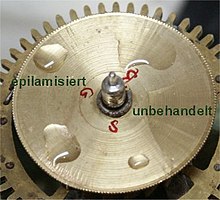Epilamization
Epilamization is a process for treating the surface of various materials by changing the surface tension . Anti- friction , anti -adhesion , water-repellent and some other special surface properties can be created.
In principle, it is the opposite of ultra-fine cleaning in which the normal (high) surface tension of the material is to be achieved again. Hydrophobic layers are created on the surface .
today
Through nano- coating ( nanotechnology ) with or plasma deposition of fluoropolymers on metals or plastics as well as direct fluorination of plastic surfaces.
Earlier
By applying a very thin stearic acid film e.g. B. on watch plates in the vicinity of lubrication points to prevent the watch oil from spreading . This product was invented by the French chemist Paul Woog and Paul Ditisheim in 1925 and was on the market without an alternative product until the late 1960s. In the 1970s, silicone-based epilams were made, but they did not catch on . From 1973 epilams were made on the basis of fluorocarbons , which are still used today in the watch industry worldwide.
properties
- Lubricants are repelled.
- Reduces surface tension by 1,000 to 10,000 times.
- The coefficient of friction is significantly reduced and wear resistance is increased.
- Epilamization makes lubricants stationary, i.e. it holds the lubricant in place on the surface and prevents it from spreading.
- Protects the surface against moisture and aggressive substances.
- Operating temperature range −200 ° C and +450 ° C
- Pressure range up to 3000 mN / mm²
- Very resistant to chemical substances and radiation .
- The layer thickness is approx. 40–80 Å .
Web links
- Dr. Tillwich GmbH Werner Stehr epilamization : functional principle, possible uses, practical applications, products
- Diener electronic lexicon epilamization

